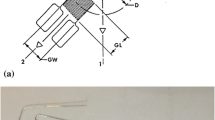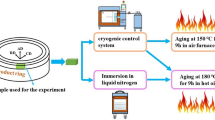Abstract
In order to improve the balance of mechanical properties and residual stress, various quenching and aging treatments were applied to Al-Cu alloy forged plate. Residual stresses determined by the x-ray diffraction method and slitting method were compared. The surface residual stress measured by x-ray diffraction method was consistent with that measured by slitting method. The residual stress distribution of samples quenched in water with different temperatures (20, 60, 80, and 100 °C) was measured, and the results showed that the boiling water quenching results in a 91.4% reduction in residual stress magnitudes compared with cold water quenching (20 °C), but the tensile properties of samples quenched in boiling water were unacceptably low. Quenching in 80 °C water results in 75% reduction of residual stress, and the reduction of yield strength is 12.7%. The residual stress and yield strength level are considerable for the dimensional stability of aluminum alloy. Quenching samples into 30% polyalkylene glycol quenchants produced 52.2% reduction in the maximum compressive residual stress, and the reduction in yield strength is 19.7%. Moreover, the effects of uphill quenching and thermal-cold cycling on the residual stress were also investigated. Uphill quenching and thermal-cold cycling produced approximately 25-40% reduction in residual stress, while the effect on tensile properties is quite slight.












Similar content being viewed by others
References
J. Robinson, R. Cudd, D. Tanner, and G.P. Dolan, Quench Sensitivity and Tensile Property Inhomogeneity in 7010 Forgings, J. Mater. Process. Technol., 2001, 119, p 261–267
J. Robinson, D.A. Tanner, C.E. Truman, A.M. Paradowska, and R.C. Wimpory, The Influence of Quench Sensitivity on Residual Stresses in the Aluminium Alloys 7010 and 7075, Mater. Charact., 2012, 65, p 73–85
G.S. Wilson, A.F. Grandt, Jr., R.J. Bucci, and R.W. Schultz, Exploiting Bulk Residual Stresses to Improve Fatigue Crack Growth Performance of Structures, Int. J. Fatigue, 2009, 31, p 1286–1299
M. Beghini, L. Bertini, and E. Vitale, Fatigue Crack Growth in Residual Stress Fields: Experimental Results and Modelling, Fatigue Fract. Eng. Mater. Struct., 1994, 17, p 1433–1444
S. Nervi, B.A. Szabó, and K.A. Young, Prediction of Distortion of Airframe Components Made from Aluminum Plates, AIAA J., 2009, 47, p 1635–1641
W. Nickola, Mechanical Relaxation of resiDual Stresses, J. ASTM Int., 1988, 993, p 7–18
J. Robinsona, S. Hossainb, and C. Trumanb, Residual Stress in 7449 Aluminium Alloy Forgings, Mater. Sci. Eng. A, 2010, 527, p 2603–2612
G. S. Sarmiento, D. M. Coscia, C. Jouglard, G. E. Totten, G. M. Webster, and J. Vega, Residual Stresses, Distortion and Heat Transfer Coefficients of 7075 Aluminum Alloy Probes Quenched in Water and Polyalkylene Glycol Solutions. In: 20th ASM Heat Treating Society Conference and Show (St Louis), 2000, p 1118–1124
D. Tanner and J. Robinson, Reducing Residual Stress in 2014 Aluminium Alloy Die Forgings, Mater. Des., 2008, 29, p 1489–1496
D.A. Lados, D. Apelian, and L. Wang, Minimization of Residual Stress in HEAT-TREATED AL-Si-Mg Cast Alloys Using Uphill Quenching: Mechanisms and Effects on Static and Dynamic Properties, Mater. Sci. Eng. A, 2010, 527, p 3159–3165
T. Croucher, Minimizing Machining Distortion in Aluminum Alloys Through Successful Application of Uphill Quenching—A Process Overview, J. ASTM Int., 2010, 1523, p 332–351
F. Kang, Z.D. Zhao, and C.K. He, Thermal Cooling Cycle on Dimensional Stability of Strip-Shaped Aluminum Alloy Parts, Spec. Cast. Nonferrous Alloy., 2009, 29, p 468–470 ((in Chinese))
H. Shao, Z.J. Liu, and J. Liu, Influence of Ageing and Thermal-Cooling Cycling Treatments on Microplastic Deformation Resistance of 2024 Al Alloy, Chin. J. Nonferrous Met., 2000, 10, p 330–333 ((in Chinese))
M. Prime, Residual Stress Measurement by Successive Extension of a Slot: A Literature Review, Appl. Mech. Rev., 1997, 52, p 75–96
S. Nervi and B.A. Szabó, On the Estimation of Residual Stresses by the Crack Compliance Method, Comput. Methods Appl. Mech. Eng., 2007, 196, p 3577–3584
G.S. Schajer and M.B. Prime, Residual Stress Solution Extrapolation for the Slitting Method Using Equilibrium Constraints, J. Eng. Mater. Technol., 2007, 129, p 226–232
G.S. Schajer and M.B. Prime, Use of Inverse Solutions for Residual Stress Measurements, J. Eng. Mater. Technol., 2006, 128, p 375–382
ABAQUS Inc., ABAQUS 6.11 Documentation, ABAQUS Inc., 2011
Protoxrd Inc., Proto-iXRD combo system user manual, Italy, 2010
A. Deschamps and Y. Bréchet, Nature and Distribution of Quench-Induced Precipitation in an Al-Zn-Mg-Cu Alloy, Scripta Mater., 1998, 39, p 1517–1522
T. Jian-guo, C. Hui, Z. Xin-ming et al., Influence of Quench-Induced Precipitation on Aging Behavior of Al-Zn-Mg-Cu alloy, Trans. Nonferrous Met. Soc. China, 2012, 22, p 1255–1263
M. Tiryakioglua and R.T. Shueyb, Quench Sensitivity of 2219-T87 Aluminum Alloy Plate, Mater. Sci. Eng. A, 2010, 527, p 5033–5037
A. Deschampsa, G. Texier, S. Ringeval, and L. Delfaut-Durutb, Influence of Cooling rate on the Precipitation Microstructure in a Medium Strength Al-Zn-Mg Alloy, Mater. Sci. Eng. A, 2009, 501, p 133–139
S. Ferreira-Barragáns, R. Fernández, P. Fernández-Castrillo, and G. González-Doncel, Kinetics of Tri-axial and Spatial Residual Stress Relaxation: Study by Synchrotron Radiation Diffraction in a 2014Al Alloy, J Alloys Compd., 2012, 523, p 94–101
J. Adrien, E. Maire, R. Estevez et al., Influence of the thermomechanical treatmenton the Microplastic Behaviour of a Wrought Al-Zn-Mg-Cu Alloy, Acta Mater., 2004, 52, p 1653–1661
Acknowledgment
This work was financially supported by Natural Science Foundation of China (No. 51171051). Y.D. acknowledges Prof. Yuexian Cui for fruitful discussion.
Author information
Authors and Affiliations
Corresponding author
Rights and permissions
About this article
Cite this article
Dong, YB., Shao, WZ., Jiang, JT. et al. Minimization of Residual Stress in an Al-Cu Alloy Forged Plate by Different Heat Treatments. J. of Materi Eng and Perform 24, 2256–2265 (2015). https://doi.org/10.1007/s11665-015-1505-2
Received:
Revised:
Published:
Issue Date:
DOI: https://doi.org/10.1007/s11665-015-1505-2




